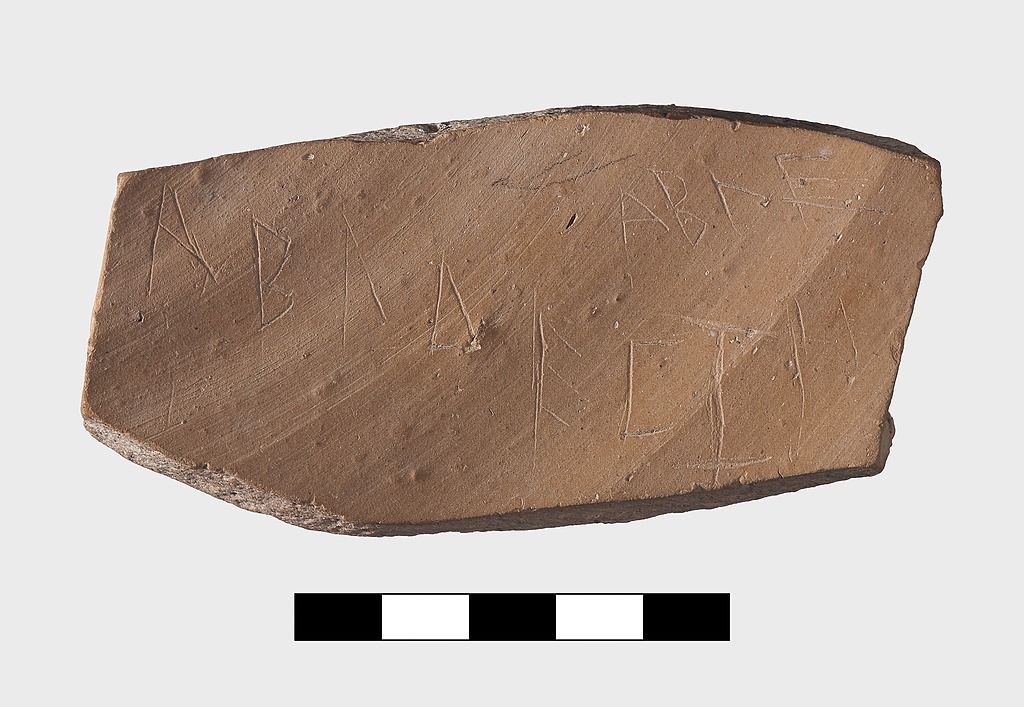1

Vowels
I. α ε η ι ο υ ω
Spell it like it sounds! As we learn the ancient Greek alphabet, it is important to note one essential principle about Greek spelling: ancient Greeks spelled words the way that they were pronounced. If the pronunciation of a word changed, so too did the spelling. Consider the verb present (preeZENT) and the noun present (PREsent), which are spelled alike but pronounced differently in English. In Greek, such words would be spelled according to their pronunciations: “preezént” and “prézent.” If a Greek community pronounced “going” as “gonna,” they would spell it as “gonna.” Homophones like “to,” “two,” and “too” would all be spelled the same, even though they have different meanings.
In English, consonants tend to dominate our words. In Greek, vowels often dominate. So we begin our introduction to the Greek alphabet with the vowels. Greek has roughly the same five vowels as English.
| Α α | alpha | “ah” | = A a |
| Ε ε | epsilon | “eh” | = E e |
| Ι ι | iota | “ih” | = I i |
| Ο ο | omicron | “o” | = O o |
| Υ υ | upsilon | “u” | = Y y |
Like English, Greek has SHORT and LONG versions of its vowels.
| SHORT | LONG |
| α “ah” | ᾱ “aah” |
| ε “eh” | η “ay” |
| ι “ih” | ῑ “ee” |
| ο “o” | ω “oh” |
| υ “u” | ῡ “ ooh” |
Notice that the letter forms for alpha, iota, and upsilon are used for both long and short vowels. The long sounds for epsilon and omicron, however, are written with different letters: eta and omega, respectively.
| Η η | eta | “ay” | = E e |
| Ω ω | omega | “oh” | = O o |
II. Two Vowels in a Row
Ancient Greek speakers tended to avoid pronouncing two different vowel sounds in a row. If two vowels came together, they preferred either to pronounce the two vowels together as one sound (called a DIPHTHONG, Greek for “double sound”), or to CONTRACT the two vowels to form either a single long vowel or diphthong (cf. S 59).
These sound changes are regular enough that they resemble a sort of alphabet math: vowel x + vowel y = vowel sound z. The sound change rules below apply to a great number of nouns, adjectives, and verbs. It is therefore essential to master the rules that follow.
Specifically:
- Any vowel + ι or υ forms a diphthong.
- The vowels α, ε and ο contract with one another.
1. Any vowel + ι or υ.
A vowel + ι forms a diphthong. The most common instances are as follows:
| α + ι | = αι | “eye” |
| ᾱ + ι | = ᾱι, usually written ᾳ | “aah” |
| ε + ι | = ει | “ay” |
| η + ι | = ηι, usually written ῃ | “ay” |
| ο + ι | = οι | “oy” |
| ω + ι | = ωι, usually written ῳ | “oh” |
| υ + ι | = υι | “wee” |
A vowel + υ forms a diphthong. The most common instances are as follows:
| α + υ | = αυ | “ow!” |
| ε + υ | = ευ | “eu” |
| ο + υ | = ου | “oo” |
2. Vowel contractions.
The short vowels α, ε and ο regularly contracted into a long vowel or diphthong when placed next to each other.
α, ε and ο + α contract as follows:
| α + α | = ᾱ |
| ε + α | = η |
| ο + α | = ω |
α, ε and ο + ε contract as follows:
| α + ε | = ᾱ |
| ε + ε | = ει |
| ο + ε | = ου |
α, ε and ο + ο contract as follows:
| α + ο | = ω |
| ε + ο | = ου |
| ο + ο | = ου |
– τὸ τέλος the end –
Key Terms and Concepts
- SPELL IT LIKE IT SOUNDS
- SHORT AND LONG VOWELS
- DIPHTHONG
- IOTA SUBSCRIPT
- VOWEL CONTRACTION
Exercises
I. Practice writing the capital and lower case vowels. For a guide to writing Greek letters, click here: How to Write Greek. Handwriting paper is available here: Lined Paper.
II. Review the combinations below, and write the diphthong or vowel that results.
- α + ε =
- ο + ο =
- α + ι =
- ο + ε =
- α + ο =
- ε + ι =
- ε + ε =
- ε + ο =
- ο + ι =
- α + α =
- α + υ =
- υ + ι =
- ε + α =
- ε + υ =
- ο + α =
- ο + υ =
